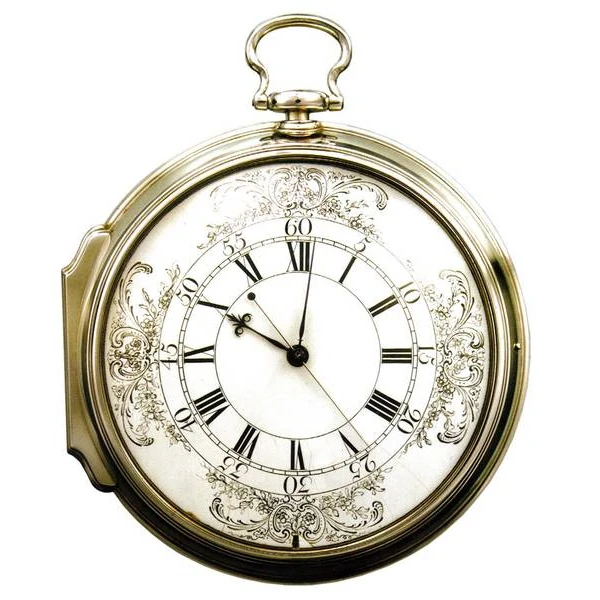
Image: Marine watch H4 (1759) by John Harrison (1693-1776), a kind of very large pocket watch. (© National Maritime Museum, Greenwich).
John Harrison was a carpenter, self-taught in watchmaking. In order to solve the longitude problem, Harrison aimed to design a portable clock that kept time with an offset of less than three seconds per day. In the mid-1720s, he designed a series of long-case clocks that achieved an accuracy of one second per month.
John Harrison's H4 watch was relatively small compared to previous marine clocks. It measured about 13 centimeters in diameter and was about 7 centimeters thick.
The need to determine the position of a ship at sea dates back to the Age of Discovery (15th and 16th century), when sailors needed to know precisely where they were in relation to their destination.
At that time, determining latitude (north-south position) was relatively simple.
By measuring the angular height of the stars (at night) or the sun (daytime) relative to the horizon, sailors could know their latitude using a sextant and astronomical tables.
During the day, they compared the angle of the position of the sun at noon with the theoretical maximum height of the sun given by the astronomical tables.
At night, they measured the height of stars or celestial bodies. By comparing the declinations of the stars and the hours of their maximum elevation with astronomical tables, they estimated their latitude.
On the other hand, the longitude (east-west position) was much more difficult to determine, because it required knowing precisely the local time of the ship and comparing it to a known reference time, generally that of the port of departure.
To measure the local time aboard ship, sailors made astronomical observations. They measured the angular heights of the stars and compared them with astronomical tables. They thus obtained the local time.
Before departure, the sailors had synchronized their marine watch with a reference clock on land. But marine watch time was prone to errors and inaccuracies because there were no marine clocks that could maintain consistent accuracy over long periods of time. In addition, marine clocks had considerable measurement deviations due to movement and jolts at sea. Sea conditions, such as waves, temperature variations and pressure changes, affected the accuracy of these clocks. The movements of the ship greatly disturbed the regular functioning of the internal mechanisms, causing fluctuations in the measurement of time. Traditional mechanical clocks could lose several tens of minutes or even more than an hour per day.
This is where John Harrison's H4 watch played a revolutionary role. It was equipped with a gyrostat which reduced the jolts, thus keeping a constant precision despite the conditions at sea. The gyrostat of the H4 watch made it possible to maintain a regular and constant oscillation.
The development of the H4 watch with its detent escapement which allows a regular release of the energy of the spring, and its gyrostat made it possible to overcome these difficulties and to obtain a much more precise and stable marine clock. It has minimized the reference time desynchronization to a few seconds per day.
Before starting their voyage, the sailors synchronized the H4 watch with a reference clock ashore. Then, at each astronomical observation, they carefully noted the time indicated by the watch. This made it possible to know the time difference between the reference H4 watch and the observed local time.
These sea clocks played a crucial role in solving the problem of longitude at sea and paved the way for less chaotic, safer and more accurate ocean navigation.